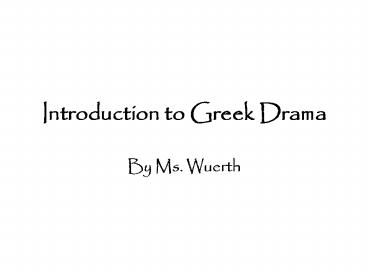Introduction to Greek Drama - PowerPoint PPT Presentation
1 / 16
Title:
Introduction to Greek Drama
Description:
Tragedy is meant to purge the soul of fear and pity emotions most humans have. Aristotle termed this purging of such emotions catharsis. ... – PowerPoint PPT presentation
Number of Views:65
Avg rating:3.0/5.0
Title: Introduction to Greek Drama
1
Introduction to Greek Drama
- By Ms. Wuerth
2
- Drama itself evolved from ancient religious
festivals in honor of the Greek god Dionysus.
Dionysus was the god of wine and the changing of
seasons. There are three types of Greek drama. - Tragedy
- Comedy
- Satyr Plays
3
Tragedyconcerns better than average people like
heroes and kings, who suffer a transition from
good fortune to bad fortune. Tragedy is meant to
purge the soul of fear and pityemotions most
humans have. Aristotle termed this purging of
such emotions catharsis. Many tragedies follow
a known myth, so the audience can easily follow
the plot.
4
Comedyconcerns average or below average people
who enjoy a transition from bad fortune to good
fortune (but not too good!). These plays often
employ informal diction. Comedies are not
necessarily funny the transition faced by the
main character is what defines a comedy.
5
An interesting difference between these two forms
is the fact that comedies usually have a
believable plot, while tragedies are almost never
believable.
6
Satyr plays can be compared to modern day
burlesque. Satyr plays were overtly sexual and
involved alcohol and pranks. Oftentimes, satyr
plays included phallic props. Satyr plays were
not nearly as popular as tragedy and comedy.
7
Playwrights submitted four plays to the Athenian
Dionysia3 tragedies and 1 satyr play.
8
This is what an ancient Greek theatre looked
like.
9
Ancient Greek plays had a chorus. Sophocles used
15 men in his choruses. The chorus represented
the collective community, but not necessarily the
poets thoughts. Each chorus had one leader who
would step out and speak with the protagonist.
The chorus entered and exited the stage through
the parodoi
10
The tragedy of Oedipus Rex
11
The tragic hero Traditionally, the tragic hero
usually has larger than life traits. For
example, Oedipus is a king. This allows readers
to imagine the fate of the hero to be more
important than their own fate. Readers should
feel pity for the tragic hero as he is demoted in
his life station.
12
The tragic hero must be imperfect as any other
human being. While imperfect, this hero still
must earn the respect of his/her audience.
Readers/viewers must be able to identify with the
flaws of the hero.
13
The tragic hero should not be a saint, or someone
too good to make a mistake. It is the
fallibility of the hero that readers can identify
with. Readers first pity the hero, then
transition to pity themselves. What if I
suffered this fate? What if this happened to
me? Aristotle termed this moment when readers
imagine themselves in the heros shoes terror.
This is not to say that you could find yourself
sleeping with your father and murdering your
mother, but it is to say that you could
experience a MASSIVE reversal of fortune at some
point in your life.
14
According to Aristotle, tragic plays often center
around the Greek concept of hubris, or excessive
pride that is likely to invoke the wrath of the
gods. However, this analysis does not leave
room for more complex characters like
Shakespeares Hamlet.
15
Dramatic Irony Dramatic irony is a literary
device in which a character, lacking the
knowledge that the audience has, does not
understand the importance of his/her own words
and actions. How is this device evident in
Oedipus?
16
Is a human responsible for the evil of his/her
actions if (s)he is truly unaware that they are
evil?































